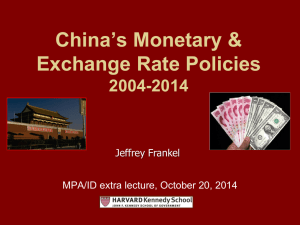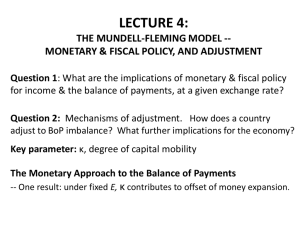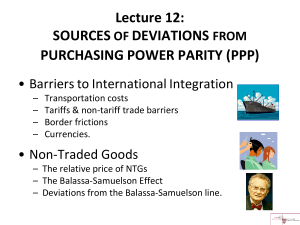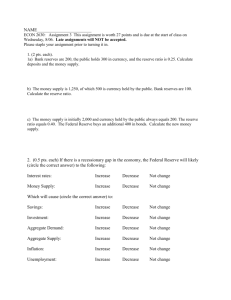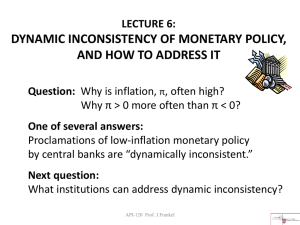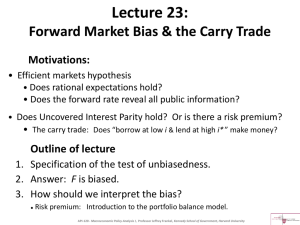LECTURE 16 -- CASE STUDY: RECENT MACROECONOMICS OF
advertisement
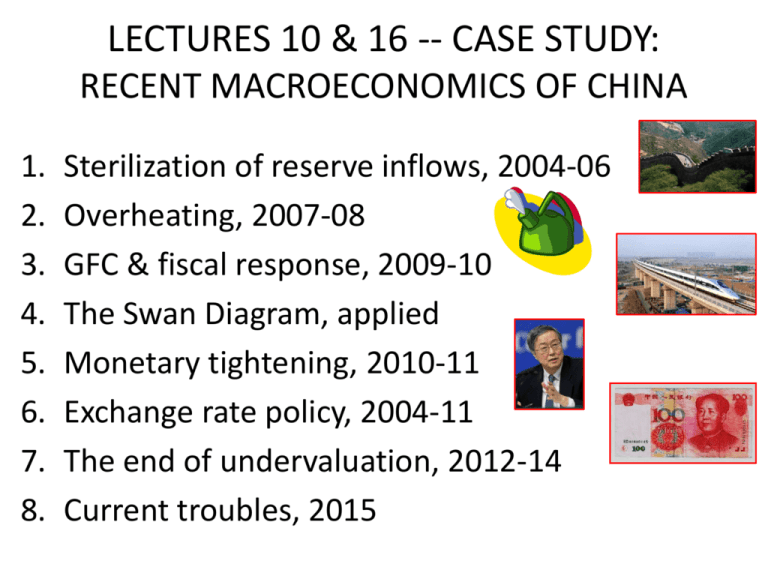
LECTURES 10 & 16 -- CASE STUDY:
RECENT MACROECONOMICS OF CHINA
1.
2.
3.
4.
5.
6.
7.
8.
Sterilization of reserve inflows, 2004-06
Overheating, 2007-08
GFC & fiscal response, 2009-10
The Swan Diagram, applied
Monetary tightening, 2010-11
Exchange rate policy, 2004-11
The end of undervaluation, 2012-14
Current troubles, 2015
1. Sterilization of reserve inflows, 2004-06
(continued from end of Lecture 4)
• Reserve accumulation
• Initially successful sterilization
• Declines in NDA
• Increases in reserve requirements
Recall that China ran large BoP surpluses after 2003.
BP ≡ dR/dt >> 0
API-120 - Prof. J.Frankel,
Harvard
http://viableopposition.blogspot.com/2012/03/chinas-holdings-of-us-treasuries-what.html
http://qz.com/171645/the-invisible-man-managing-chinas-3-8-trillion-in-reserves-just-stepped-down
The People’s Bank of China sold sterilization bills,
taking cash RMB out of circulation (dNDA/dt < 0)
and so counteracted increases in Net Foreign Reserves.
Source: Zhang, 2011,
Fig.7, p.47.
In 2003-06, the PBoC had little trouble
sterilizing the rising reserve inflows:
overall MB expansion was relatively steady (at ≈ 10%/yr.).
Growth of Monetary Base & its components:
\
FX reserve contribution
Source: HKMA, Half-Yearly Monetary & Financial Stability Report, June 2008
API-120 - Prof. J.Frankel, Harvard
The sterilization shows up as a steadily rising
share of foreign reserves (vs. domestic assets)
in the holdings of the People’s Bank of China, R/MB.
Chang, Liu & Spiegel, 2015, “Capital Controls and Optimal Chinese Monetary Policy” FRB SF WP 2012-13, Fig. 1, p.26
Another tool: The PBoC raised banks’ required reserve ratios,
thus sterilizing in the broad sense of slowing M1, even as MB grew.
Chinese Banks’ Average Reserve Ratio
Source: Zhang, 2011,
Fig.6, p.46.
API-120 - Prof. J.Frankel, Harvard
(2) 2007-08: Sterilization faltered
(i) The PBoC began to run “quasi-fiscal deficit”
or “negative carry.”
(ii) Money growth accelerated.
(iii) The economy overheated.
(i) “Cost of carry”: By 2008 the cost of domestic funds
exceeded the interest rate PBoC was earning
on its foreign reserves (US Treasury bills).
}
Cost of carry
Chang, Liu & Spiegel, 2015, “Capital Controls and Optimal Chinese Monetary Policy,” FRB SF WP 2012-13
Sterilization eventually faltered, continued
(ii) Money accelerated sharply in 2007-08.
Sterilization eventually faltered, continued
(iii) Signs of overheating in 2007-08:
a. Real growth > 10%
probably > potential.
b. Inflation became a serious problem.
c. Also a “bubble” in the Shanghai stock market.
(a) Real growth > 10% in 2007-08
Growth > 10%
L6 appendix
(b) China’s CPI accelerated in 2007-08.
Inflation 1999 to 2008
Source: HKMA, Half-Yearly Monetary and Financial Stability Report, June 2008
API-120 - Prof. J.Frankel, Harvard
L4 appendix
(c) Apparent 2007-08 bubble in China’s stock market
Data from EconStatsTM, Reuters, and major online news outlets such as the BBC & NYT.
L4 appendix
The PBoC tightened money by raising reserve ratios
and also raising lending rates
while continuing to underpay depositors:
{
“financial
repression”
Source: HKMA, Half-Yearly Monetary & Financial Stability Report, June 2008
3. Global recession & response:
The macroeconomy in 2009-11
• The global recession hit in 2008, 4th quarter,
– originating in the “North Atlantic financial crisis.”
– It cut China’s exports by 1/4.
• Growth and inflation fell sharply.
• The government responded with a big
counter-cyclical fiscal stimulus in 2009.
• The economy returned to rapid growth in 2010,
– even excess demand in 2011.
China was hit by the global recession in late 2008.
2005-July 2015
Chinese government investment spending in 2009
counteracted the recession.
}
A rise in public investment
offset the loss of export
demand in 2009.
Reserve Bank of Australia
China’s inflation broke sharply in 2009,
But took off again in 2010-11.
Inflation 2001 to 2011
API-120 - Prof. J.Frankel, Harvard
WTP, Ch. 18.2 or 20.2
4. The Swan Diagram
• To derive the diagram, assume an economy starts from:
– external balance, say, TB = 0;
– and internal balance, Y = 𝑌.
E
• Consider an expansion in demand: A↑.
• Implications for external balance:
– At a given exchange rate, A↑ => TB < 0.
– If TB is to be restored, would need E↑.
– So the BB curve slopes up.
• Implications for internal balance:
•
• •
BB
TB<0
A
E
– At a given exchange rate, A↑ => Y > 𝑌. I.e., EDG.
– If Y = 𝑌 is to be restored, we would need E↓.
– So the YY curve slopes down.
YY
• •
EDG
•
A
China’s position in the Swan Diagram in 2008 showed
a large TB surplus plus overheating. It called for appreciation.
ED & TB>0
China
Excgange rate E
in RMB/$
BB:
External balance
CA=0
2006-08
ES & TB>0
ED & TD
China
2002
YY:
Internal balance
Y=𝑌
ES & TD
Spending A
21
China’s 2009 position in the Swan Diagram: Hit by global recession.†
The government responded by increasing spending.
ED & TB>0
China
2008
Exchange rate E
in RMB/$
China
2009
BB:
External balance
CA=0
China
2010-11
ED & TD
ES & TB>0
ES & TD
YY:
Internal balance
Y=𝑌
† Loss of export demand => YY curve shifts out.
Spending A
22
5. Monetary tightening, 2010-11
Overheating resumed in 2010.
Annual change in CPI, through August 2015
Again, inflation soon rose.
Besides general inflation,
overheating in 2010 also showed up in rapidly rising land prices.
Real Beijing land prices
API-120 - Prof. J.Frankel, Harvard
When house prices rise relative even to rents,
it suggests easy money or a bubble.
API-120 - Prof. J.Frankel, Harvard
Scott Reeve blog
China in 2010 resumed raising reserve requirements
in a renewed attempt to rein in M1 growth.
API-120 - Prof. J.Frankel, Harvard
China tightened monetary policy in 2011,
as it had in 2007: raising interest rates & reserve requirements.
June 1, 2015, Fiscal Times,
http://www.thefiscaltimes.com/Columns/2015/06/01/Why-China-s-Stock-Bubble-Isn-t-Ready-Burst
𝑑𝑦
?
𝑑𝑡
Monetary tightening
came in response
to overheating,
each time: 2004,
2008,
& 2010-11.
API-120 - Prof. J.Frankel, Harvard
Fxtimes.com
Besides tightening monetary policy in 2011, China also tightened
macro-prudential policies, particularly in housing finance:
Loan-to-Value and Debt-Service-to-Income limits
Interest rate and credit policies in China
Fig.3, Kenneth Kuttner & Ilhyock Shim, “Can non-interest rate policies stabilize
housing markets? Evidence from a panel of 57 economies,” NBER WP 19723, 2013.
Chinese inflation, once again,
began to ease off after 2011
API-120 - Prof. J.Frankel, Harvard
6. Exchange Rate Policy, 2005-11
As of 2005-2008, there were several good reasons to
allow RMB appreciation, leaving aside US pressure.
i.
External balance: Reserves were increasing rapidly
–
–
ii.
to levels high enough for precautionary purposes.
Sterilization would become more difficult.
Internal balance: The economy was overheating.
iii. Currency regime: A country as large as China
should have a flexible exchange rate.
–
Better to exit the peg in good times than in crisis.
iv. PPP: The RMB was “undervalued” by the price criterion
–
even taking into account China’s GDP/cap (Balassa-Samuelson).
Frankel, 2006, "On the Yuan: The Choice Between Adjustment Under a Fixed Exchange Rate
and Adjustment under a Flexible Rate," Understanding the Chinese Economy, G. Illing, ed. (Oxford U. Press).
2005
1
-1
-.5
0
.5
The Balassa-Samuelson Relationship
-3
-2
-1
0
1
Log of Real Per capita GDP (PPP)
2
coef = .23367193, (robust) se = .01978263, t = 11.81
Source: Arvind Subramanian, PB10-08, Peterson Institute for International Economics, 2010.
Undervaluation of RMB in the 2005 regression estimated above = 26%.
Estimated 2005 undervaluation averaging across four such estimates = 31%.
Compare to estimate for 2000 (Frankel 2005): 36%.
Or, as recently as 2009 (Chang 2012): 25% .
32
The RMB was allowed to rise against the $ 2006-08,
though it returned to a peg in mid-2008.
33
Appreciation versus the US $,
nominal and real, 2005-11
1.5
1.4
CNY/USD,
2005M06=1
1.3
real
1.2
nominal
1.1
1.0
0.9
2005
2006
2007
2008
2009
2010
2011
Appreciation vs. index of currencies,
nominal and real, 2005-11
1.35
1.30
CNY Index,
2005M06=1
1.25
1.20
Real value
of CNY
1.15
Value
of CNY
1.10
1.05
1.00
0.95
2005
2006
2007
2008
2009
2010
2011
7. The end of undervaluation? 2011-14
Various key measures suggest that China achieved much
of the needed trade adjustment between 2009 & 2013:
• Substantial real appreciation of the RMB
has brought it closer to equilibrium.
– Some nominal appreciation &
– Some price inflation and, especially, wage increases.
• Its current account surplus peaked in 2008
– > 10% of GDP
– and then narrowed dramatically, to ≈2% in 2013.
Adjustment of relative prices
• The famous “China price”:
– Ever since China rejoined the world economy
3 decades ago, its trading partners have been snapping
up exports of manufacturing goods,
– because low Chinese wages made them
super-competitive on world markets.
• But relative prices adjusted
– following the laws of market economics.
Adjustment of relative prices, continued
• The change in relative prices is reflected
as real exchange rate appreciation.
– This comprises, in part, nominal appreciation
– and, in part, Chinese inflation.
– Government officials might have been better advised
to let more of the real appreciation take the form
of nominal appreciation ($ per RMB).
– But since they didn’t, it showed up as inflation instead.
A trend of real appreciation since 2005
Dooley, Folkerts-Landau, Garber (2014)
Against an average of currencies,
rather than just the $, the RMB hit a record high in 2014.
40
http://www.cesifo-group.de/ifoHome/policy/EEAG-Report/Archive/EEAG_Report_2015/eeag_2015_report.html
China’s trade & CA surplus peaked in 2007, and then fell
as % of GDP.
Sean Miner, “China’s Current Account in 2014 ” Feb. 8th, 2015, PIIE
China runs a deficit in primary products,
offset by a surplus in manufactures.
Source: Reserve Bank of Australia (June 2013)
China’s trade balance, continued
The bilateral surplus with the United States
is as big as ever – which has no economic importance,
but is politically sensitive.
43
The natural adjustment process was delayed.
• 1st, because the authorities intervened to keep
the exchange virtually fixed against the dollar,
in the years 1995-2005 and 2008-2010.
• 2nd, wages had not fully adjusted to (rising) marginal
product of labor in coastal factories
– surplus labor in countryside (A.Lewis, 1954)
– impediments to migration (hukou system).
• China continued to undersell the world.
But prices eventually adjusted.
• Labor shortages began to appear =>
China’s urban workers won rapid wage hikes.
• Meanwhile another cost of business,
land prices, rose even more rapidly.
• The yuan was finally allowed to appreciate
against the $ during 2005-08 & 2010-11,
by 25% cumulatively
• =17% + 8%,
• though less against other currencies.
Chinese wages rose
Source: “China’s wage inflation,” marketrealist.com, Aug. 28, 2013
46
In response to rising wages, some labor-intensive
manufacturing has moved back out of China.
Mexican employment is rising
Source: Noel Maurer, April 2013
47
Balassa-Samuelson estimated for 2011
In 2014, the ICP released new absolute price data.
“Is the Renminbi Still Undervalued? Not According to New PPP Estimates”
M.Kessler & A.Subramanian, PIIE, May 2014
Benchmark years
GDP per capita (in PPP dollars)
RMB undervaluation (percent)
2005
2011
4,802
10,057
-34.5
-9.7
API-120 - Prof. J. Frankel
6 types of adjustment are gradually reallocating resources
in response to the new high level of costs
in the factories of China’s coastal provinces:
• 1st, some manufacturing is migrating inland,
– where wages & land prices are still relatively low.
• 2nd, export operations are shifting to Vietnam or Bangla Desh
– where wages are lower still.
• 3rd, Chinese companies are beginning to automate,
– substituting capital for labor.
• 4th, they are moving into more sophisticated products,
– following the path blazed earlier by Japan, Korea, & other Asian tigers
• in the “flying geese” formation.
• 5th, multinational companies that had in the past moved some stages
of their production process to China, out of the US
or other high-wage countries, are now moving back.
6th dimension of adjustment:
expansion of the services sector.
• China has had great past success in manufacturing
– especially via exports and investment.
• It is time for the other side of the economy to catch up:
services, via domestic demand, especially consumption
– Retail, education, environmental quality,
– health care, pensions, social safety net.
• American politicians find it hard to let go of the syllogism
that seemed so unassailable just a decade ago:
– (1) The Chinese have joined the world economy;
– (2) their wages are $0.50 an hour;
– (3) there are a billion of them, and so
– (4) their exports will rise without limit:
“Chinese wages will never be bid up in line
with the usual textbook laws of economics
because the supply labor is infinitely elastic.”
• But it turns out that the laws of economics do eventually
apply after all -- even in China.
8. Current troubles
In 2014-15,
growth slowed
substantially,
probably below
the official 7 %.
The PBoC responded by cutting interest
rates, Nov. 2014-Aug. 2015…
…which boosted
the stock market.
Aug. 25, 2015
The stock market underwent an apparent bubble in the 1st half of 2015.
You would not guess it from the commentary, but: the stock market regulator raised
margin requirements three times, in January & April and on June 12.
American congressmen did not got the memo, but:
Chinese foreign exchange reserves
have been falling since June 2014.
through September 2015
DATA SOURCE: PEOPLE’S BANK OF CHINA, via TRADINGECONOMICS.COM
See appendices
i. Is China’s 2014-15 slowdown a new trend?
– If so, is it a middle-income growth trap?
ii. Countercyclical use of macro-prudential policies
by China & some other Asian countries.
iii. Did China’s GDP surpass the US in 2014?
